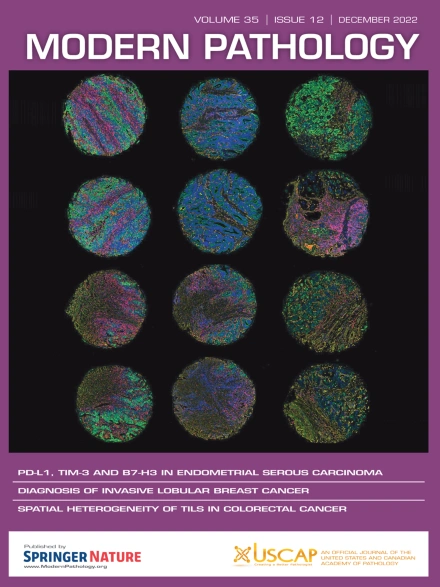The Histologic Spectrum of Rituximab-Associated Common Variable Immunodeficiency-Like Enteropathy
IF 7.1
1区 医学
Q1 PATHOLOGY
引用次数: 0
Abstract
Rituximab (RTX) is a monoclonal anti-CD20 antibody widely used to treat B-cell neoplasms and autoimmune conditions. RTX has recently been linked to an enteropathy characterized by diarrhea, malabsorption, and hypogammaglobulinemia, closely resembling common variable immunodeficiency (CVID) enteropathy. We present the first dedicated histopathologic assessment of RTX-associated CVID-like enteropathy. Study inclusion criteria were the presence of diarrhea, weight loss, or other gastrointestinal symptoms in the setting of current/prior RTX use and associated hypogammaglobulinemia. Twenty-two patients (15 male:7 female; mean age at biopsy/resection, 63.4 years) across 9 tertiary medical centers met inclusion criteria and had small bowel (N = 20) and/or colon (N = 17) specimens (biopsies/resections) available for review; 71.4% of specimens dated from ≤5 years of last RTX dose. Cases were systematically evaluated by gastrointestinal pathologists at each institution. Key histologic features in the small bowel included sparse/absent lamina propria plasma cells (N = 10; 50%), intraepithelial lymphocytosis (N = 12; 60%), villous atrophy (N = 11; 55%), increased crypt apoptotic bodies (N = 6; 30%), and active inflammation (N = 5; 25%). Common features in the colon included sparse/absent plasma cells (N = 7; 41.2%), increased crypt apoptotic bodies (N = 7; 41.2%), active inflammation (N = 5; 29.4%), and intraepithelial lymphocytosis (N = 4; 23.5%). Goblet cell loss was appreciated in small bowel and/or colon specimens from 2 patients. Follow-up biopsies (interval, 2 months to 4 years) were available for 7 patients and largely recapitulated the histology of the index specimens, though 1 patient demonstrated improvement in villous blunting and intraepithelial lymphocytosis. In summary, the histologic spectrum of post-RTX CVID-like enteropathy encompasses lamina propria plasma cell depletion, increased crypt apoptotic bodies, small bowel villous atrophy, and goblet cell loss. While the underlying pathophysiology remains uncertain, the clinicopathologic picture may reflect post-RTX B-cell/plasma cell impairment. Although histologic findings may be subtle and variable, pathologists should be aware of this entity and should seek a history of RTX use in patients whose biopsies exhibit these CVID enteropathy-like features.
利妥昔单抗相关的常见可变免疫缺陷样肠病的组织学谱
Rituximab (RTX)是一种单克隆抗cd20抗体,广泛用于治疗b细胞肿瘤和自身免疫性疾病。RTX最近与以腹泻、吸收不良和低γ球蛋白血症为特征的肠病有关,与常见可变免疫缺陷(CVID)肠病非常相似。我们提出了第一个专门的rtx相关cvid样肠病的组织病理学评估。研究纳入标准是当前/既往使用RTX的患者存在腹泻、体重减轻或其他胃肠道症状,并伴有低γ -球蛋白血症。22例患者(男15例,女7例;9个三级医疗中心的活组织检查/切除时的平均年龄为63.4岁,符合纳入标准,并有小肠(N = 20)和/或结肠(N = 17)标本(活组织检查/切除)可供审查;71.4%的标本可追溯到最后一次RTX剂量≤5年。每个机构的胃肠病理学家对病例进行了系统的评估。小肠的主要组织学特征包括固有层浆细胞稀疏/缺失(N = 10;50%),上皮内淋巴细胞增多症(N = 12;60%),绒毛萎缩(N = 11;55%),隐窝凋亡小体增加(N = 6;30%),活动性炎症(N = 5;25%)。结肠的常见特征包括浆细胞稀疏/缺失(N = 7;41.2%),隐窝凋亡小体增多(N = 7;41.2%),活动性炎症(N = 5;29.4%),上皮内淋巴细胞增多症(N = 4;23.5%)。在2例患者的小肠和/或结肠标本中发现杯状细胞丢失。随访活检(间隔2个月至4年)对7例患者进行了随访,并在很大程度上概括了指数标本的组织学,尽管1例患者表现出绒毛钝化和上皮内淋巴细胞增多的改善。总之,rtx后cvid样肠病的组织学谱包括固有层浆细胞耗损、隐窝凋亡小体增加、小肠绒毛萎缩和杯状细胞损失。虽然潜在的病理生理仍不确定,但临床病理图像可能反映rtx后b细胞/浆细胞损伤。尽管组织学结果可能是微妙的和可变的,但病理学家应该意识到这一实体,并在活检显示这些CVID肠病样特征的患者中寻求RTX的使用史。
本文章由计算机程序翻译,如有差异,请以英文原文为准。
求助全文
约1分钟内获得全文
求助全文
来源期刊

Modern Pathology
医学-病理学
CiteScore
14.30
自引率
2.70%
发文量
174
审稿时长
18 days
期刊介绍:
Modern Pathology, an international journal under the ownership of The United States & Canadian Academy of Pathology (USCAP), serves as an authoritative platform for publishing top-tier clinical and translational research studies in pathology.
Original manuscripts are the primary focus of Modern Pathology, complemented by impactful editorials, reviews, and practice guidelines covering all facets of precision diagnostics in human pathology. The journal's scope includes advancements in molecular diagnostics and genomic classifications of diseases, breakthroughs in immune-oncology, computational science, applied bioinformatics, and digital pathology.
 求助内容:
求助内容: 应助结果提醒方式:
应助结果提醒方式:


